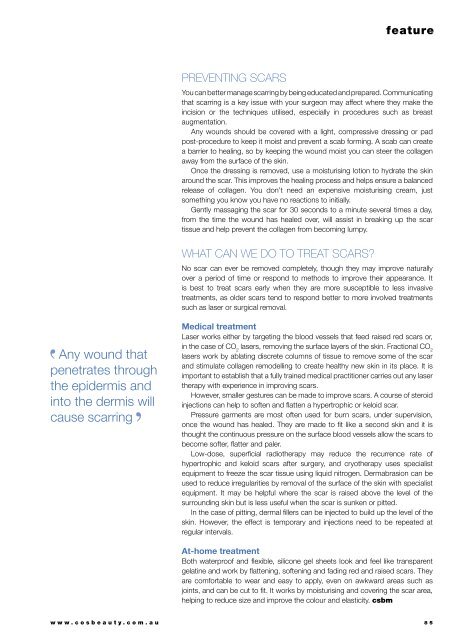Cosmetic Surgery and Beauty Magazine #68
Create successful ePaper yourself
Turn your PDF publications into a flip-book with our unique Google optimized e-Paper software.
feature<br />
Preventing scars<br />
You can better manage scarring by being educated <strong>and</strong> prepared. Communicating<br />
that scarring is a key issue with your surgeon may affect where they make the<br />
incision or the techniques utilised, especially in procedures such as breast<br />
augmentation.<br />
Any wounds should be covered with a light, compressive dressing or pad<br />
post-procedure to keep it moist <strong>and</strong> prevent a scab forming. A scab can create<br />
a barrier to healing, so by keeping the wound moist you can steer the collagen<br />
away from the surface of the skin.<br />
Once the dressing is removed, use a moisturising lotion to hydrate the skin<br />
around the scar. This improves the healing process <strong>and</strong> helps ensure a balanced<br />
release of collagen. You don’t need an expensive moisturising cream, just<br />
something you know you have no reactions to initially.<br />
Gently massaging the scar for 30 seconds to a minute several times a day,<br />
from the time the wound has healed over, will assist in breaking up the scar<br />
tissue <strong>and</strong> help prevent the collagen from becoming lumpy.<br />
What can we do to treat scars?<br />
No scar can ever be removed completely, though they may improve naturally<br />
over a period of time or respond to methods to improve their appearance. It<br />
is best to treat scars early when they are more susceptible to less invasive<br />
treatments, as older scars tend to respond better to more involved treatments<br />
such as laser or surgical removal.<br />
Any wound that<br />
penetrates through<br />
the epidermis <strong>and</strong><br />
into the dermis will<br />
cause scarring<br />
Medical treatment<br />
Laser works either by targeting the blood vessels that feed raised red scars or,<br />
in the case of CO 2<br />
lasers, removing the surface layers of the skin. Fractional CO 2<br />
lasers work by ablating discrete columns of tissue to remove some of the scar<br />
<strong>and</strong> stimulate collagen remodelling to create healthy new skin in its place. It is<br />
important to establish that a fully trained medical practitioner carries out any laser<br />
therapy with experience in improving scars.<br />
However, smaller gestures can be made to improve scars. A course of steroid<br />
injections can help to soften <strong>and</strong> flatten a hypertrophic or keloid scar.<br />
Pressure garments are most often used for burn scars, under supervision,<br />
once the wound has healed. They are made to fit like a second skin <strong>and</strong> it is<br />
thought the continuous pressure on the surface blood vessels allow the scars to<br />
become softer, flatter <strong>and</strong> paler.<br />
Low-dose, superficial radiotherapy may reduce the recurrence rate of<br />
hypertrophic <strong>and</strong> keloid scars after surgery, <strong>and</strong> cryotherapy uses specialist<br />
equipment to freeze the scar tissue using liquid nitrogen. Dermabrasion can be<br />
used to reduce irregularities by removal of the surface of the skin with specialist<br />
equipment. It may be helpful where the scar is raised above the level of the<br />
surrounding skin but is less useful when the scar is sunken or pitted.<br />
In the case of pitting, dermal fillers can be injected to build up the level of the<br />
skin. However, the effect is temporary <strong>and</strong> injections need to be repeated at<br />
regular intervals.<br />
At-home treatment<br />
Both waterproof <strong>and</strong> flexible, silicone gel sheets look <strong>and</strong> feel like transparent<br />
gelatine <strong>and</strong> work by flattening, softening <strong>and</strong> fading red <strong>and</strong> raised scars. They<br />
are comfortable to wear <strong>and</strong> easy to apply, even on awkward areas such as<br />
joints, <strong>and</strong> can be cut to fit. It works by moisturising <strong>and</strong> covering the scar area,<br />
helping to reduce size <strong>and</strong> improve the colour <strong>and</strong> elasticity. csbm<br />
www.cosbeauty.com.au 85


















